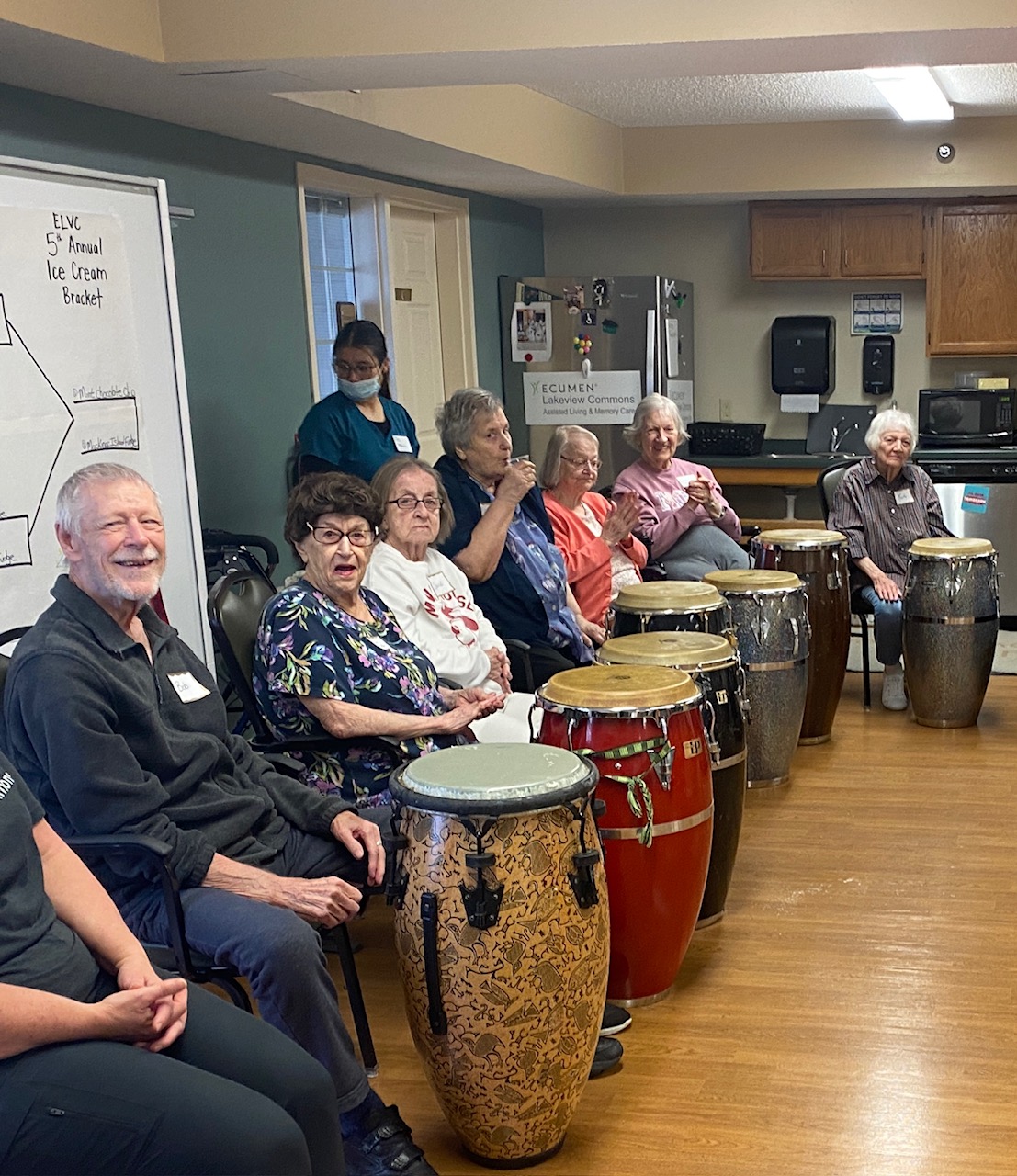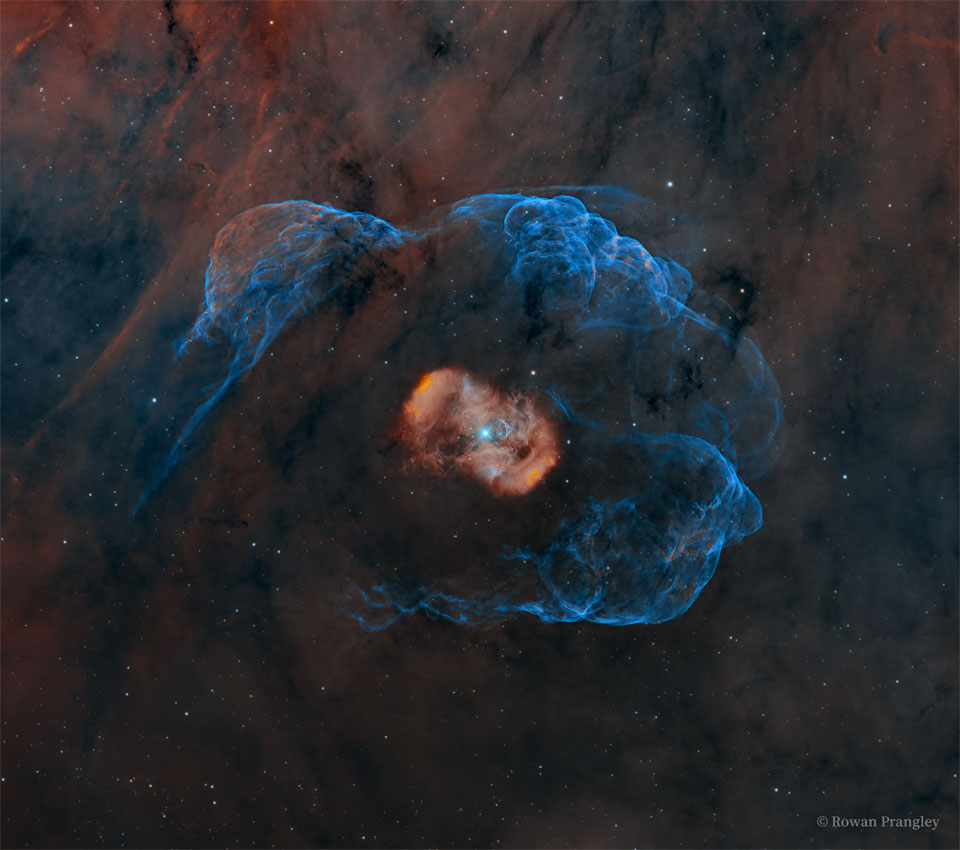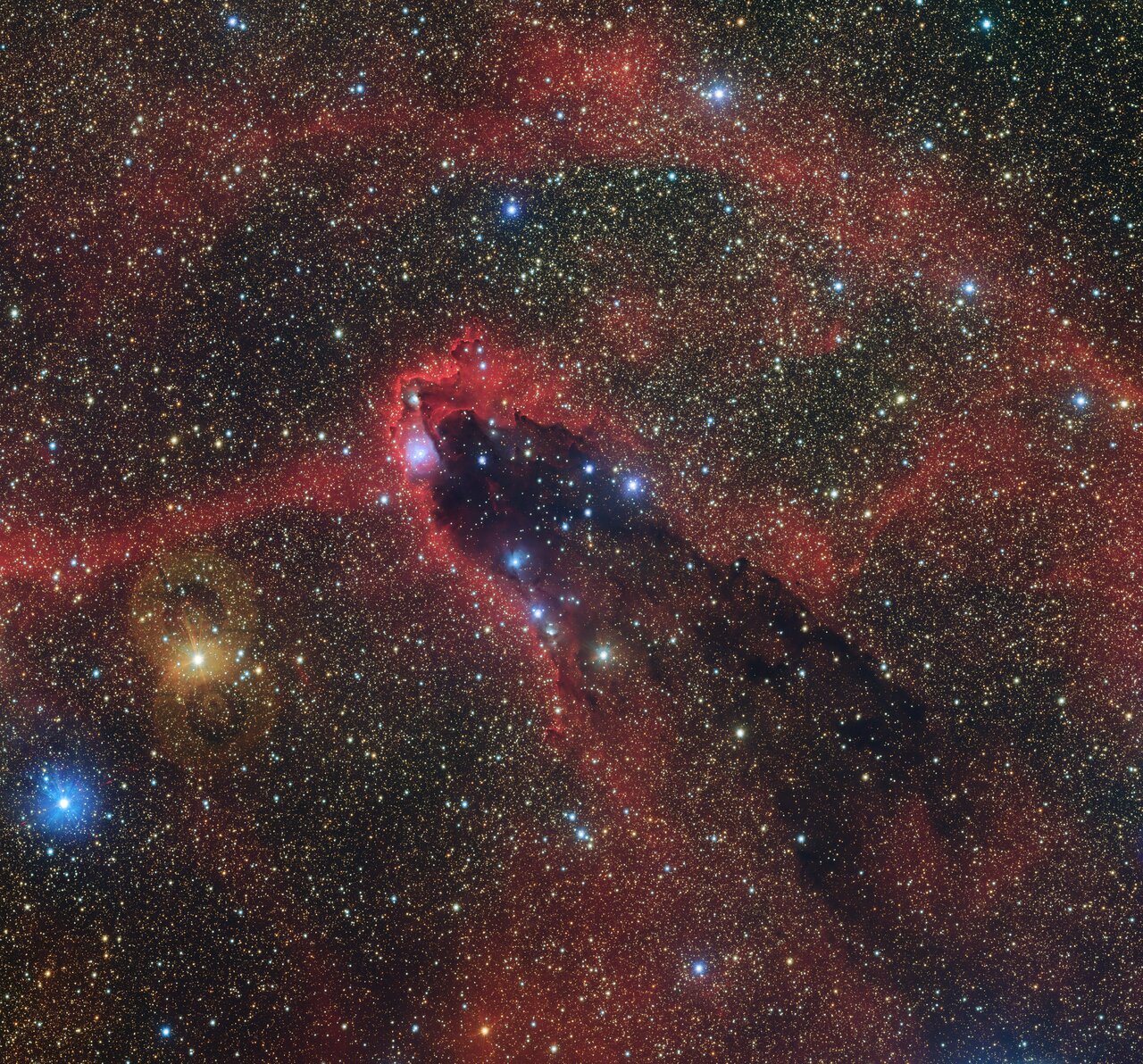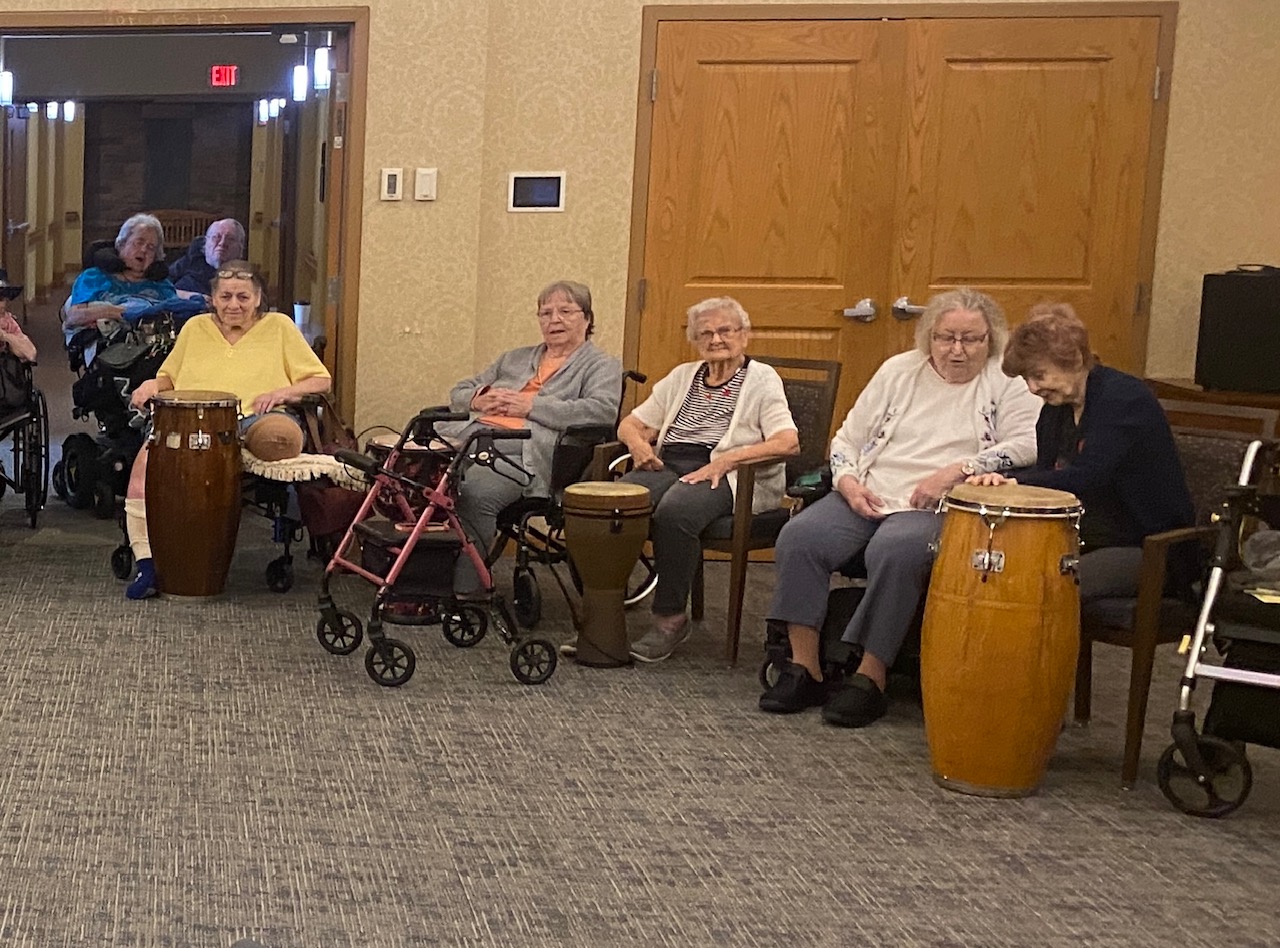Blog

In the middle of emission nebula NGC 6164 is an unusually massive star. The central star has been compared to an oyster’s pearl and an egg protected by the mythical sky dragons of Ara. The star, visible in the center of the featured image and catalogued as HD 148937, is so hot that the ultraviolet light it emits heats up gas that surrounds it. That gas was likely thrown off from the star previously, possibly the result of a gravitational interaction with a looping stellar companion. Expelled material might have been channeled by the magnetic field of the massive star, in all creating the symmetric shape of the bipolar nebula. NGC 6164 spans about four light years and is located about 3,600 light years away toward the southern constellation Norma.

Reuben Bloom (April 24, 1902 – March 30, 1976) was an American songwriter, pianist, arranger, band leader, recording artist, vocalist, and author.
Bloom was born and died in New York City. He was Jewish.
During his career, he worked with many well-known performers, including Bix Beiderbecke, Joe Venuti, Ruth Etting, Stan Kenton, Tommy and Jimmy Dorsey. He collaborated with a wide number of lyricists, including Johnny Mercer, Ted Koehler, and Mitchell Parish.
During the 1920s he wrote many novelty piano solos, which are still well regarded today. He recorded for the Aeolian Company’s Duo-Art reproducing piano system various titles including his “Spring Fever”. His first hit came in 1927 with “Soliloquy”; his last was “Here’s to My Lady” in 1952, which he wrote with Johnny Mercer. In 1928, he made a number of records with Joe Venuti’s Blue Four for OKeh, including five songs he sang, as well as played piano.
more...John Christopher Williams AO OBE (born 24 April 1941) is an Australian-born classical guitarist renowned for his ensemble playing as well as his interpretation and promotion of the modern classical guitar repertoire. In 1973, he shared a Grammy Award in the Best Chamber Music Performance category with fellow guitarist Julian Bream for Together (released in the US as Julian and John (Works by Lawes, Carulli, Albéniz, Granados)). Guitar historian Graham Wade has said that “John is perhaps the most technically accomplished guitarist the world has seen.”
John Williams is an only child who was born on 24 April 1941 in Melbourne to an English father, Len Williams, who bought John, at age four, his first guitar with a modified neck. Len would later found the Spanish Guitar Centre in London, England. John’s mother Melaan (née Ah Ket) was the daughter of William Ah Ket, the first Australian barrister of Chinese heritage. In 1952, the family moved to England, where John attended Friern Barnet Grammar School, London.
Williams was initially taught guitar by his father, who was a musically disciplined and accomplished classical guitarist. From the age of 11, Williams attended summer courses with Andrés Segovia at the Accademia Musicale Chigiana in Siena, Italy. He attended the Royal College of Music in London, from 1956 to 1959, studying piano because the college did not have a guitar section. In 1958, when he was 17 years old, he made his musical debut performing publicly at London’s Wigmore Hall. Upon graduating from his college, he was invited to create and then to run their guitar department for its first two years of life. Williams maintains links with the college (and also with the Royal Northern College of Music in Manchester).
more...Joe Henderson (April 24, 1937 – June 30, 2001) was an American jazz tenor saxophonist. In a career spanning more than four decades, Henderson played with many of the leading American players of his day and recorded for several prominent labels, including Blue Note, Milestone, and Verve.
Born in Lima, Ohio, Henderson was one of 14 children. He was encouraged by his parents, Dennis and Irene (née Farley) and older brother James T. to study music. He dedicated his first album to them “for being so understanding and tolerant” during his formative years. Early musical interests included drums, piano, saxophone and composition. According to trumpeter Kenny Dorham, two local piano teachers who went to school with Henderson’s brothers and sisters, Richard Patterson and Don Hurless, gave him a knowledge of the piano. He was particularly enamored of his brother’s record collection.
A hometown drummer, John Jarette, advised Henderson to listen to musicians like Lester Young, Stan Getz, Dexter Gordon and Charlie Parker. He also liked Flip Phillips, Lee Konitz and the Jazz at the Philharmonic recordings. However, Parker became his greatest inspiration. Henderson’s first approach to the saxophone was under the tutelage of Herbert Murphy in high school. During this time, he wrote several scores for the school band.
By age 18, Henderson was active on the Detroit jazz scene of the mid-’50s, playing in jam sessions with visiting New York City stars. While attending classes for flute and bass at Wayne State University, he further developed his saxophone and compositional skills under the guidance of renowned teacher Larry Teal at the Teal School of Music. In late 1959, he formed his first group. By the time he arrived at Wayne State University, he had transcribed and memorized so many Lester Young solos that his professors believed he had perfect pitch. Henderson’s college classmates included Yusef Lateef, Barry Harris and Donald Byrd. He also studied music at Kentucky State College.
more...John Arnold Griffin III (April 24, 1928 – July 25, 2008) was an American jazz tenor saxophonist. Nicknamed “the Little Giant” for his short stature and forceful playing, Griffin’s career began in the mid-1940s and continued until the month of his death. A pioneering figure in hard bop, Griffin recorded prolifically as a bandleader in addition to stints with pianist Thelonious Monk, drummer Art Blakey, in partnership with fellow tenor Eddie “Lockjaw” Davis and as a member of the Kenny Clarke/Francy Boland Big Band after he moved to Europe in the 1960s. In 1995, Griffin was awarded an Honorary Doctorate of Music from Berklee College of Music.
Griffin studied music at DuSable High School in Chicago under Walter Dyett, starting out on clarinet before moving on to oboe and then alto saxophone. While still at high school at the age of 15, Griffin was playing with T-Bone Walker in a band led by Walker’s brother.
Alto saxophone was still his instrument of choice when he joined Lionel Hampton‘s big band, three days after his high school graduation, but Hampton encouraged him to take up the tenor, playing alongside Arnett Cobb. He first appeared on a Los Angeles recording with Hampton’s band in 1945 at the age of 17.
By mid-1947, Griffin and fellow Hampton band member Joe Morris, had formed a sextet made up of local musicians, including George Freeman, where he remained for the next two years. His playing can be heard on early rhythm and blues recordings for Atlantic Records. By 1951, Griffin was playing baritone saxophone in an R&B septet led by former bandmate Arnett Cobb.
more...Astronomers are well-known for naming objects with odd conventions, and the cometary globule GN 16.43.7.01 seen in this Picture of the Week is no exception. Cometary globules have nothing to do with comets aside from appearance: they are named for their dusty head and elongated, dark tail, as seen in this image taken with the VLT Survey Telescope (VST) hosted at ESO’s Paranal Observatory in Chile. This globule, dubbed the Dark Tower — astronomers compensate with obvious names — lies about 5000 light-years away from Earth in the southern constellation Scorpius (the Scorpion). It contains dense clumps of collapsing gas and dust out of which stars will be born. The curious shape of this object is carved out from an intense bombardment of radiation from a cluster of young, bright stars located off-camera to the upper-left. This radiation has swept around and outlined the cometary globule with the characteristic pink glow of hot, excited matter.

Robert Marshall Rosengarden (April 23, 1924 – February 27, 2007) was an American jazz drummer, percussionist and bandleader. A native of Elgin, Illinois, United States, he played on many recordings and in television orchestras and talk show bands.
Rosengarden began playing drums when he was 12, and later studied at the University of Michigan. After playing drums in Army bands in World War II, he moved to New York City, working in several groups between 1945 and 1948, before becoming a busy studio musician. He played at NBC-TV (1949–1968) and ABC (1969–1974) on The Steve Allen Show, The Ernie Kovacs Show, Sing Along With Mitch, Johnny Carson‘s The Tonight Show Band, and led the band for The Dick Cavett Show.
more...Charles Edward “Cow Cow” Davenport (April 23, 1894 – December 3, 1955) was an American boogie-woogie and piano blues player as well as a vaudeville entertainer. He also played the organ and sang.
Davenport, who also made recordings under the pseudonyms of Bat The Humming Bird, George Hamilton and The Georgia Grinder, is a member of the Alabama Music Hall of Fame.
He was born in Anniston, Alabama, United States, one of eight children. Davenport started to play the piano at age 12. His father objected strongly to his musical aspirations and sent him to a theological seminary, where he was expelled for playing ragtime.
Davenport’s career began in the 1920s when he joined the K.G. Barkoot Traveling Carnival. His initial profile came as accompanist to blues musicians Dora Carr and Ivy Smith. Davenport and Carr performed as a vaudeville act as “Davenport & Co”, and he performed with Smith as the “Chicago Steppers”. He also performed with Tampa Red. Davenport recorded for many record labels, and was a talent scout and artist for Vocalion Records. Davenport suffered a stroke in 1938 and lost movement in his hands. He was washing dishes when he was found by the jazz pianist Art Hodes. Hodes assisted in his rehabilitation and helped him find new recording contracts.
more...Sergei Sergeyevich Prokofiev (27 April [O.S. 15 April] 1891 – 5 March 1953) was a Russian composer, pianist, and conductor who later worked in the Soviet Union. As the creator of acknowledged masterpieces across numerous music genres, he is regarded as one of the major composers of the 20th century. His works include such widely heard pieces as the March from The Love for Three Oranges, the suite Lieutenant Kijé, the ballet Romeo and Juliet—from which “Dance of the Knights” is taken—and Peter and the Wolf. Of the established forms and genres in which he worked, he created—excluding juvenilia—seven completed operas, seven symphonies, eight ballets, five piano concertos, two violin concertos, a cello concerto, a symphony-concerto for cello and orchestra, and nine completed piano sonatas.
A graduate of the Saint Petersburg Conservatory, Prokofiev initially made his name as an iconoclastic composer-pianist, achieving notoriety with a series of ferociously dissonant and virtuosic works for his instrument, including his first two piano concertos. In 1915, Prokofiev made a decisive break from the standard composer-pianist category with his orchestral Scythian Suite, compiled from music originally composed for a ballet commissioned by Sergei Diaghilev of the Ballets Russes. Diaghilev commissioned three further ballets from Prokofiev—Chout, Le pas d’acier and The Prodigal Son—which, at the time of their original production, all caused a sensation among both critics and colleagues. But Prokofiev’s greatest interest was opera, and he composed several works in that genre, including The Gambler and The Fiery Angel. Prokofiev’s one operatic success during his lifetime was The Love for Three Oranges, composed for the Chicago Opera and performed over the following decade in Europe and Russia.
After the Revolution of 1917, Prokofiev left Russia with the approval of Soviet People’s Commissar Anatoly Lunacharsky, and resided in the United States, then Germany, then Paris, making his living as a composer, pianist and conductor. In 1923 he married a Spanish singer, Carolina (Lina) Codina, with whom he had two sons; they divorced in 1947. In the early 1930s, the Great Depression diminished opportunities for Prokofiev’s ballets and operas to be staged in America and Western Europe. Prokofiev, who regarded himself as a composer foremost, resented the time taken by touring as a pianist, and increasingly turned to the Soviet Union for commissions of new music; in 1936, he finally returned to his homeland with his family. His greatest Soviet successes included Lieutenant Kijé, Peter and the Wolf, Romeo and Juliet, Cinderella, Alexander Nevsky, the Fifth and Sixth Symphonies, On Guard for Peace, and the Piano Sonatas Nos. 6–8.
The Nazi invasion of the USSR spurred Prokofiev to compose his most ambitious work, an operatic version of Leo Tolstoy’s War and Peace; he co-wrote the libretto with Mira Mendelson, his longtime companion and later second wife. In 1948, Prokofiev was attacked for producing “anti-democratic formalism“. Nevertheless, he enjoyed personal and artistic support from a new generation of Russian performers, notably Sviatoslav Richter and Mstislav Rostropovich: he wrote his Ninth Piano Sonata for the former and his Symphony-Concerto for the latter.
more...Vernice “Bunky” Green Jr (born April 23, 1935) is an American jazz alto saxophonist and educator.
Green was raised in Milwaukee, Wisconsin, where he played the alto saxophone, mainly at a local club called “The Brass Rail”.
Green’s first break came when he was hired in New York City by Charles Mingus as a replacement for Jackie McLean in the 1950s. His brief stint with the bass player and composer made a deep impression. Mingus’ sparing use of notation and his belief that there was no such thing as a wrong note had a lasting influence on Green’s own style.
Green moved to Chicago, Illinois, where he performed with players such as Sonny Stitt, Louie Bellson, Andrew Hill, Yusef Lateef, and Ira Sullivan. Originally strongly influenced by Charlie Parker, Green spent a period reassessing his style and studying, emerging with a highly distinctive sound that has deeply influenced a number of younger saxophonists, including Steve Coleman and Greg Osby.
more...Monday April 22nd 2024 third Class. Teaching a Rhythm Roots Workshop Residency. At Ecumen North Branch Senior Living twice a week Mondays & Thursdays 1-230pm starting Monday April 15th 2024 thru May 13th. Celebrating world cultures through drumming and chanting.

This Hubble Picture of the Week depicts the spiral galaxy ESO 422-41, which lies about 34 million light-years from Earth in the constellation Columba. The patchy, star-filled structure of the galaxy’s spiral arms and the glow from its dense core are laid out in intricate detail here by Hubble’s Advanced Camera for Surveys. Images of this galaxy have, however, a decades-long history.
The name ESO 422-41 comes from its identification in the European Southern Observatory (B) Atlas of the Southern Sky. In the times before automated sky surveys with space observatories such as ESA’s Gaia, many stars, galaxies and nebulae were discovered by means of large photographic surveys. Astronomers used the most advanced large telescopes of the time to produce hundreds of photographs, covering an area of the sky. They later studied the resulting photographs, attempting to catalogue all the new astronomical objects revealed.
In the 1970s a new telescope at ESO’s La Silla facility in Chile performed such a survey of the southern sky, which still had not been examined in as much depth as the sky in the north. At the time, the premier technology for recording images was glass plates treated with chemicals. The resulting collection of photographic plates became the ESO (B) Atlas of the Southern Sky. Astronomers at ESO and in Uppsala, Sweden collaborated to study the plates, recording hundreds of galaxies — ESO 422-41 being just one of those — star clusters, and nebulae. Many were new to astronomy.
Astronomical sky surveying has since transitioned through digital, computer-aided surveys such as the Sloan Digital Sky Survey and the Legacy Surveys, to surveys made by space telescopes including Gaia and the Wide-Field Infrared Survey Explorer. Even so, photographic sky surveys contributed immensely to astronomical knowledge for decades, and the archives of glass plates serve as an important historical reference for large swathes of the sky. Some are still actively used today, for instance to study variable stars through time. And the objects that these surveys revealed, including ESO 422-41, can now be studied in depth by telescopes such as Hubble.
[Image Description: A spiral galaxy, with a brightly shining core and two large arms. The arms are broad, faint overall and quite patchy, and feature several small bright spots where stars are forming. A few foreground stars with small diffraction spikes can be seen in front of the galaxy.]

Cándido Camero Guerra (22 April 1921 – 7 November 2020), known simply as Cándido, was a Cuban conga and bongo player. He is considered a pioneer of Afro-Cuban jazz and an innovator in conga drumming. He was responsible for the embracing of the tuneable conga drum, the first to play multiple congas developing the techniques that all players use today, as well as the combination of congas, bongos, and other instruments such as the foot-operated cowbell, an attached guiro, all played by just one person. Thus he is the creator of the multiple percussion set-up.
After moving to New York in 1946, Camero played with Dizzy Gillespie, Billy Taylor and Stan Kenton, and from 1956 he recorded several albums as a leader.His biggest success came in 1979 with his discorecordings for Salsoul. He continued to perform until the late 2010s, recording several albums for the audiophile label Chesky Records, including Inolvidable, with Graciela, which earned him a nomination at the 47th Annual Grammy Awards.
more...Paul Laurence Dunbar Chambers Jr. (April 22, 1935 – January 4, 1969) was an American jazz double bassist. A fixture of rhythm sections during the 1950s and 1960s, he has become one of the most widely-known jazz bassists of the hard bop era. He was also known for his bowed solos. Chambers recorded about a dozen albums as a leader or co-leader, and over 100 more as a sideman, especially as the anchor of trumpeter Miles Davis‘s “first great quintet” (1955–63) and with pianist Wynton Kelly (1963–68).
Born in Pittsburgh, Pennsylvania, on April 22, 1935, to Paul Lawrence Chambers and Margaret Echos. He was brought up in Detroit, Michigan, following the death of his mother. He began playing music with several of his schoolmates on the baritone horn. Later he took up the tuba. “I got along pretty well, but it’s quite a job to carry it around in those long parades, and I didn’t like the instrument that much”. During the course of his lifetime Paul Chambers developed addictions to both alcohol and heroin. He was hospitalized at the end of 1968 with what was thought to be a severe case of influenza, but tests revealed that he had tuberculosis. As his organ functions deteriorated, Chambers lapsed into a coma for 18 days. It is believed that his addictions to heroin and alcohol contributed to his health problems. On January 4, 1969, he died of tuberculosis aged 33.
more...
More Posts
- Vangelis
- Astrud Gilberto
- Flamenco Fridays José Anillo, y Rafael Rodríguez
- Daily Roots Barrington Levy
- Celestial Antiquity CANCELLED
- Cosmos NGC 2077
- Gary Willis
- Tete Montoliu
- Thad Jones
- World Fusion Mixed World Ensemble
- Daily Roots Dennis Brown
- Cosmos Abell 1656
- Johnny Copeland
- Sarah Vaughan
- Ben Webster
- World lMusic Daymé Arocena
- Daily Roots Errol Dunkley
- Cosmos Comet 12P/Pons–Brooks
- Diana Ross
- James Moody




